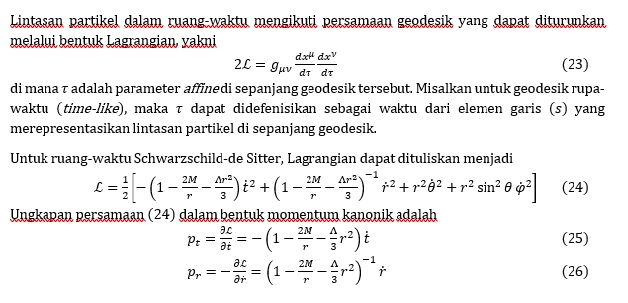
Sifat Lubang Hitam Schwarzschild-de Sitter dalam Background Semesta yang Berekspansi Dipercepat
Abstract
Keywords
Full Text:
PDFReferences
S. W. Hawking and W. Israel (eds.), Three Hundred Years of Gravitation (Cambridge University Press, 1987).
K. S. Thorne, R. H. Price and A. MacDonald, Black Holes: The Membrane Paradigm (Yale University Press, New Haven, 1976).
Einstein, A. (1923). "Kosmologische Betrachtungen zur allgemeinen Relativitätstheorie". Das Relativitätsprinzip, : 130-139.
Rugh, S; Zinkernagel, H. (2001). "The Quantum Vacuum and the Cosmological Constant Problem". Studies in History and Philosophy of Modern Physics. 33 (4): 663-705. arXiv:hep-th/0012253.
A. I. Lonappan, S. Kumar, Ruchika, A. A. Sen. (2017). "Bayesian Evidences for dark energy models in light of current observational data". Physical Review D. 97 (4) : 043524. arXiv:1707.00603.
A. G. Lemaitre, A. S. Eddington. (1931). "The Expanding Universe". Monthly Notices of the Royal Astronomical Society. 91 (5) : 490-501.
E. Hubble. (1929). "A Relation Between Distance and Radial Velocity Among Extra-Galactic Nebulae". Proc. Nat. Acad. Sci. 15 : 168-173
S. Weinberg, Gravitation and Cosmology: Principles and Applications of the General Theory of relativity (J. Wiley & Sons, New York 1972).
E. Harrison, Cosmology : The Science of Universe 2nd edition (Cambridge University Press, 2012).
E. Harrison. (1993). "The Redshift-Distance and Velocity-Distance Laws". Astrophys. J. 403 : 28-31.
L. D. Landau and E. M. Lifshitz, The classical theory of fields (Elsevier Sci. Inc., New York 1975).
T. R. Choudhury and T. Padmanbahan. (2007). Concept of temperaure in multi-horizons spacetimes. Gen. Relativ. Grav. 39 : 1789-1811.
S. Weinberg, Cosmology. (Oxford University Press Inc., New York, 2008).
T. Padmanabhan. (2002). "Classical and Quantum Thermodynamics of Horizons in Spherical Symmetry Spacetimes". Class. Quantum Grav. 9 : 5387-5409
T. Padmanabhan. (2005). "Gravity and the Thermodynamics of Horizons". Phys. Rep. 406 : 49.
A. Riess et al., (1998). "Observational Evidence from Supernovae for an Accelerating Universe and a Cosmological Constant". Astron. J. 116 : 1009.
S. J. Perlmutter et al., (1999). "Measurements of Omega and Lambda from 42 High-Redshift Supernovae". Astrophys. J. 517 : 565.
W. Zimdahl, D. J. Schwarz, A. B. Balakin and D. Pavon, .(2001). "Cosmic anti-friction and accelerated expansion". Phys. Rev. D 64. 063501.
G. Bene, V. Czinner and M. Vasth, (2006). "Accelerating expansion of the universe may be caused by inhomogeneities". Mod. Phys. Lett. A 21 : 1117.
K. Enqvist, (2008). "Lemaitre-Tolman-Bondi model and accelerating expansion". Gen. Relativ. Gravit. 40 : 451-466.
A. Sheykhi, B. Wang and R. G. Cai, (2007). "Thermodynamical properties of apparent horizon in warped DGP braneworld". Nucl. Phys. B 779 : 1-12.
A. Sheykhi, B. Wang and R. G. Cai, (2007). "Deep connection between thermodynamics and gravity in Gauss-Bonnet braneworlds". Phys. Rev. D 76, 023515.
A. Sheykhi, J. Cosmol. (2009). "Thermodynamical interpretation of gravity in braneworld scenarios". Astropart. Phys. 05 : 019.
R. C. Tolman, (1934). "On Thermodynamics Equilibrium in a Static Einstein Universe". Proc. Nat. Acad. Sci. USA 20 : 410.
A. H. Abbassi, and S. Khosravi, (2010). "On Kerr-de Sitter Metric". Int. J. Mod. Phys. A 25 : 837.
J. T. Firouzjaee, (2012). "The Sperical Symmetry Black Hole Collapse in Expanding Universe". Int. J. Mod. Phys. D 21, 1250039.
F. Kottler, (1918). "Uber die Physikalischen Grundlagen der Eisntenchen Gravitationstheorie". Ann. Phys. 56 : 401.
H. Weyl, (1919). "Eine neue Erweiterung der Relativitätstheorie". Phys. Z. 20 : 31.
E. Trefftz, (1922). "Das statische Gravitationsfeld zweier Massenpunkte in der Einsteinschen Theorie". Math. Ann. 86 : 317.
B. C. Nolan, (1999). "A point mass in an isotropic universe: III. The region R ≤ 2 m". Class. Quantum Grav. 16 : 1227.
M. Iihoshi, S. V. Ketov and A. Morishita, (2007). "CONFORMALLY FLAT FRW METRICS". Prog. Theor. Phys. 118 : 475.
N. Riazi, H. Moradpour and A. Amiri, (2011). "Physical and Mathematical Properties of Conformally RW Spacetimes". Prog. Theor. Phys. 126 : 1145
V. Mukhanov, Physical Foundations of Cosmology (Cambridge University Press, Cambridge, 2005).
M. Visser, Lorentzian Wormholes: From Einstein to Hawking (American Institute of Physics, New York, 1995).
J. L. Tonry et al., (2003) . "Cosmological Results From High-Z Supernovae". Astrophys. J. 594 : 1.
U. Alam, V. Sahni, T. D. Saini and A. A. Starobinsky, (2004). "Is There Supernova evidence for dark energy metamorphosis?" Mon. Not. R. Astron. Soc. 354 : 275.
T. R. Choudhury and T. Padmanabhan, (2005). "Cosmological parameters from supernova observations: A critical comparison of three data sets". Astron. Astrophys. 429 : 807
J. S. Alcaniz, (2004). "Testing dark energy beyond the cosmological constant barrier". Phys. Rev. D 69, 083521.
G.W. Gibbons, S.W. Hawking, (1977). "Cosmological event horizons, thermodynamics, and particle creation". Phys. Rev. D 15 : 2738.
R. Bousso, S.W. Hawking, (1996). "Pair Creation of Black Hole during inflation". Phys. Rev. D 54 : 6312
Y. Sekiwa, (2006). "Thermodynamics of de SItter black holes - Thermal Cosmological Constant". Phys. Rev. D 73, 084009.
M. Urano, A. Tomimatsu, H. Saida, (2009). Mechanical First Law of Black Hole Spacetimes with Cosmological Constant and Its Application to Schwarzschild-de Sitter Spacetime". Class. Quantum Gravity 26, 105010.
V. Iyer, R.M. Wald, (1994). "Some properties of the Noether charge and a proposal for dynamical black hole entropy". Phys. Rev. D 50 : 846.
J. Labbe, A. Barrau, J. Grain, (2006). " Phenomenology of black hole evaporation with a cosmological constant". PoS HEP 2005 : 013.
DOI: https://doi.org/10.34312/ljpa.v1i2.21833
Copyright (c) 2023

This work is licensed under a Creative Commons Attribution 4.0 International License.


